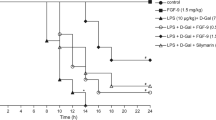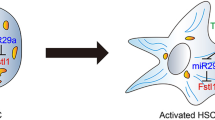Abstract
Liver fibrosis is caused by the accumulation of extracellular matrix proteins on the surface of hepatocytes and results from chronic liver injury. TGFβ1 is one of the most important promoters of hepatic fibrosis, which accelerates the transformation of hepatic stellate cells to myofibroblasts and collagen expression. It is well-known that TGFβ1 binds to TGFβR2 to mediate its downstream signal cascades to regulate target gene transcription. Therefore, the TGFβR2 blocker might be a prominent drug candidate. We constructed TGFβR2 extracellular domain into living biotherapeutics Lactococcus lactis to reduce hepatic fibrosis in CCl4 treated mice in the present study. We found that the culture supernatant of the recombinant bacteria can inhibit the TGFβ1-induced collagen synthesis in the hepatic stellate cells at the cellular level. In addition, results of in vivo study showed that the recombinant bacteria significantly reduced the degree of liver fibrosis in CCl4-treated mice. Furthermore, flow cytometry results indicated that the recombinant bacteria treatment significantly reduced the CD11b+ Kupffer cells compared with the empty vector bacteria group. Consistently, fibrosis-related gene and protein expression were significantly reduced upon recombinant bacteria treatment. Finally, the subchronic toxicity test results showed that this bacteria strain did not have any significant side effects. In conclusion, our recombinant Lactococcus lactis shows tremendous therapeutic potential in liver fibrosis.
Key points
• The supernatant of L. lactis expressing TGFβR2 inhibits the activation of myofibroblast.
• The oral recombinant strain reduced the degree of liver fibrosis and inflammation in mice.
• The recombinant strain was safe in subchronic toxicity test in mice.




Similar content being viewed by others
Data availability
Not applicable.
Code availability
Not applicable.
References
Al-Dhamin Z, Liu L, Li D, Zhang S, Dong S, Nan Y (2020) Therapeutic efficiency of bone marrow-derived mesenchymal stem cells for liver fibrosis: a systematic review of studies. World J Gastroenterol 26(47):7444–7469. https://doi.org/10.3748/wjg.v26.i47.7444
Arias M, Lahme B, Van de Leur E, Gressner AM, Weiskirchen R (2002) Adenoviral delivery of an antisense RNA complementary to the 3’ coding sequence of transforming growth factor-β1 inhibits fibrogenic activities of hepatic stellate cells. Cell Growth Differ 13(6):265–273
Ashrafizadeh M, Najafi M, Orouei S, Zabolian A, Saleki H, Azami N, Sharifi N, Hushmandi K, Zarrabi A, Ahn K (2020a) Resveratrol modulates transforming growth factor-beta (TGF-β) signaling pathway for disease therapy: a new insight into its pharmacological activities. Biomedicines 8(8):261. https://doi.org/10.3390/biomedicines8080261
Ashrafizadeh M, Zarrabi A, Hushmandi K, Zarrin V, Moghadam E, Hashemi F, Makvandi P, Samarghandian S, Khan H, Hashemi F, Najafi M, Mirzaei H (2020b) Toward regulatory effects of curcumin on transforming growth factor-beta across different diseases: a review. Front Pharmacol 11:585413. https://doi.org/10.3389/fphar.2020.585413
Böttcher K, Pinzani M (2017) Pathophysiology of liver fibrosis and the methodological barriers to the development of anti-fibrogenic agents. Adv Drug Deliv Rev 121:3–8. https://doi.org/10.1016/j.addr.2017.05.016
Bahey-El-Din M (2012) Lactococcus lactis-based vaccines from laboratory bench to human use: an overview. Vaccine 30(4):685–690. https://doi.org/10.1016/j.vaccine.2011.11.098
Cordero-Espinoza L, Huch M (2018) The balancing act of the liver: tissue regeneration versus fibrosis. J Clin Invest 128(1):85–96. https://doi.org/10.1172/jci93562
Deng J, Yang Q, Cai X, Zhou J, E W, An Y, Zheng Q, Hong M, Ren Y, Guan J, Wang G, Lai S, Chen Z (2020) Early use of dexamethasone increases Nr4a1 in Kupffer cells ameliorating acute liver failure in mice in a glucocorticoid receptor-dependent manner. J Zhejiang Univ Sci B 21(9):727-739. https://doi.org/10.1631/jzus.B2000249
Dewidar B, Meyer C, Dooley S, Meindl-Beinker A (2019) TGF-β in hepatic stellate cell activation and liver fibrogenesis-updated 2019. Cells 8(11):1419. https://doi.org/10.3390/cells8111419
Dooley S, ten Dijke P (2012) TGF-β in progression of liver disease. Cell Tissue Res 347(1):245–256. https://doi.org/10.1007/s00441-011-1246-y
Friedman SL (2000) Molecular regulation of hepatic fibrosis, an integrated cellular response to tissue injury. J Biol Chem 275(4):2247–2250. https://doi.org/10.1074/jbc.275.4.2247
Friedman SL (2008) Mechanisms of hepatic fibrogenesis. Gastroenterology 134(6):1655–1669. https://doi.org/10.1053/j.gastro.2008.03.003
Gressner AM, Weiskirchen R, Breitkopf K, Dooley S (2002) Roles of TGF-beta in hepatic fibrosis. Front Biosci 7:d793-807
Heidebach T, Först P, Kulozik U (2012) Microencapsulation of probiotic cells for food applications. Crit Rev Food Sci Nutr 52(4):291–311. https://doi.org/10.1080/10408398.2010.499801
Henderson NC, Iredale JP (2012) Standing down the guard: stellate cells leave quietly. Gastroenterology 143(4):890–892. https://doi.org/10.1053/j.gastro.2012.08.014
Inagaki Y, Okazaki I (2007) Emerging insights into transforming growth factor beta Smad signal in hepatic fibrogenesis. Gut 56(2):284–292. https://doi.org/10.1136/gut.2005.088690
Li L, Li H, Zhang Z, Zheng J, Shi Y, Liu J, Cao Y, Yuan X, Chu Y (2018) Recombinant truncated TGF-β receptor II attenuates carbon tetrachloride-induced epithelial-mesenchymal transition and liver fibrosis in rats. Mol Med Rep 17(1):315–321. https://doi.org/10.3892/mmr.2017.7845
Lim PY, Tan LL, Ow DS, Wong FT (2017) A propeptide toolbox for secretion optimization of Flavobacterium meningosepticum endopeptidase in Lactococcus lactis. Microb Cell Fact 16(1):221. https://doi.org/10.1186/s12934-017-0836-0
Lynch R, Hawley C, Pellicoro A, Bain C, Iredale J, Jenkins S (2018) An efficient method to isolate Kupffer cells eliminating endothelial cell contamination and selective bias. J Leukoc Biol 104(3):579–586. https://doi.org/10.1002/jlb.1ta0517-169r
Massagué J (2012) TGFβ signalling in context. Nat Rev Mol 13(10):616–630. https://doi.org/10.1038/nrm3434
Mattice K, Marangoni A (2020) Functionalizing zein through antisolvent precipitation from ethanol or aetic acid. Food Chem 313:126127. https://doi.org/10.1016/j.foodchem.2019.126127
Morello E, Bermúdez-Humarán LG, Llull D, Solé V, Miraglio N, Langella P, Poquet I (2008) Lactococcus lactis, an efficient cell factory for recombinant protein production and secretion. J Mol Microbiol Biotechnol 14(1–3):48–58. https://doi.org/10.1159/000106082
Nouaille S, Ribeiro LA, Miyoshi A, Pontes D, Le Loir Y, Oliveira SC, Langella P, Azevedo V (2003) Heterologous protein production and delivery systems for Lactococcus lactis. Genet Mol Res 2(1):102–111
Pérez Tamayo R (1983) Is cirrhosis of the liver experimentally produced by CCl4 and adequate model of human cirrhosis? Hepatology 3(1):112–120. https://doi.org/10.1002/hep.1840030118
Recknagel RO, Glende EA Jr, Dolak JA, Waller RL (1989) Mechanisms of carbon tetrachloride toxicity. Pharmacol Ther 43(1):139–154. https://doi.org/10.1016/0163-7258(89)90050-8
Roehlen N, Crouchet E, Baumert T (2020) Liver fibrosis: mechanistic concepts and therapeutic perspectives. Cells 9(4):875. https://doi.org/10.3390/cells9040875
Sato A, Nakashima H, Nakashima M, Ikarashi M, Nishiyama K, Kinoshita M, Seki S (2014) Involvement of the TNF and FasL produced by CD11b Kupffer cells/macrophages in CCl4-induced acute hepatic injury. PLoS ONE 9(3):e92515. https://doi.org/10.1371/journal.pone.0092515
Slater TF, Cheeseman KH, Ingold KU (1985) Carbon tetrachloride toxicity as a model for studying free-radical mediated liver injury. Philos Trans R Soc Lond B Biol Sci 311(1152):633–645. https://doi.org/10.1098/rstb.1985.0169
Tacke F, Zimmermann H (2014) Macrophage heterogeneity in liver injury and fibrosis. J Hepatol 60(5):1090–1096. https://doi.org/10.1016/j.jhep.2013.12.025
Tavares LM, de Jesus LCL, da Silva TF, Barroso FAL, Batista VL, Coelho-Rocha ND, Azevedo V, Drumond MM, Mancha-Agresti P (2020) Novel strategies for efficient production and delivery of live biotherapeutics and biotechnological uses of Lactococcus lactis: the lactic acid bacterium model. Front Bioeng Biotechnol 8:517166. https://doi.org/10.3389/fbioe.2020.517166
Theisen M, Adu B, Mordmüller B, Singh S (2017) The GMZ2 malaria vaccine: from concept to efficacy in humans. Expert Rev Vaccines 16(9):907–917. https://doi.org/10.1080/14760584.2017.1355246
Tsochatzis EA, Bosch J, Burroughs AK (2014) Liver cirrhosis. Lancet 383(9930):1749–1761. https://doi.org/10.1016/s0140-6736(14)60121-5
Tsuchida T, Friedman SL (2017) Mechanisms of hepatic stellate cell activation. Nat Rev Gastroenterol Hepatol 14(7):397–411. https://doi.org/10.1038/nrgastro.2017.38
van Oss C (1989) On the mechanism of the cold ethanol precipitation method of plasma protein fractionation. J Protein Chem 8(5):661–668. https://doi.org/10.1007/bf01025606
Wynn TA, Ramalingam TR (2012) Mechanisms of fibrosis: therapeutic translation for fibrotic disease. Nat Med 18(7):1028–1040. https://doi.org/10.1038/nm.2807
Yata Y, Gotwals P, Koteliansky V, Rockey DC (2002) Dose-dependent inhibition of hepatic fibrosis in mice by a TGF-beta soluble receptor: implications for antifibrotic therapy. Hepatology 35(5):1022–1030. https://doi.org/10.1053/jhep.2002.32673
Yu Y, Feng XH (2019) TGF-β signaling in cell fate control and cancer. Curr Opin Cell Biol 61:56–63. https://doi.org/10.1016/j.ceb.2019.07.007
Acknowledgements
We thank Huiru Lian (University College London, London, UK) for revising the language of the manuscript.
Funding
This work was supported by the General Program (Major Research Plan) of the National Natural Science Foundation of China (92057208), the National Key Research and Development Program of China (2017YFC1001003), and the National Natural Science Foundation of China (81770834).
Author information
Authors and Affiliations
Contributions
W. Z. J. designed experiments, analyzed the data, and revised the manuscript. W. X. and J. C. revised the manuscript. S. L. Y. performed experiments, analyzed the data, and wrote the manuscript. M. D. and H. L. Z performed experiments, analyzed the data, and revised the manuscript. Q. W. analyzed the data. H. D. X and C. L. Y. performed experiments. Other authors helped with the experiments. All authors read and approved the manuscript.
Corresponding authors
Ethics declarations
Ethics approval
The animal experiment was approved by the Institutional Animal Care and Use Committee of Institute of Zoology, Chinese Academy of Sciences.
Consent to participate
Not applicable.
Consent for publication
Not applicable.
Conflict of interest
W. Z. J. filed a patent on this study.
Additional information
Publisher's note
Springer Nature remains neutral with regard to jurisdictional claims in published maps and institutional affiliations.
Supplementary Information
Below is the link to the electronic supplementary material.
Rights and permissions
About this article
Cite this article
Yuan, S., Dong, M., Zhang, H. et al. Oral delivery of a Lactococcus lactis expressing extracellular TGFβR2 alleviates hepatic fibrosis. Appl Microbiol Biotechnol 105, 6007–6018 (2021). https://doi.org/10.1007/s00253-021-11485-7
Received:
Revised:
Accepted:
Published:
Issue Date:
DOI: https://doi.org/10.1007/s00253-021-11485-7




